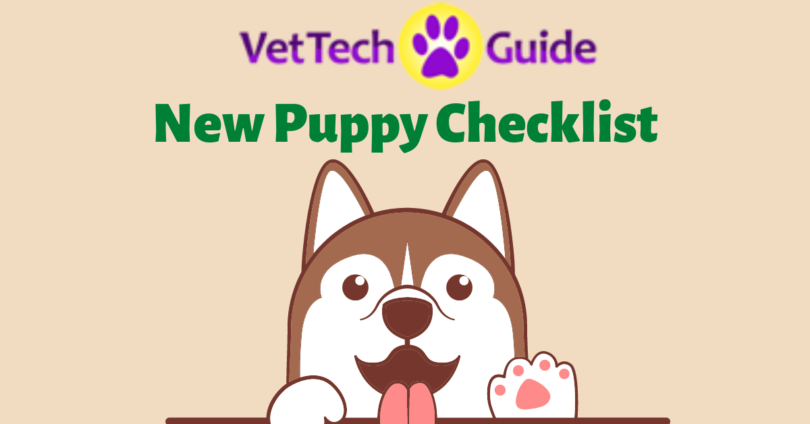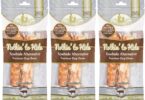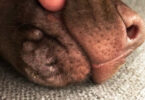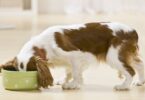Bringing a puppy home is an exciting time. I doubt you will even get much sleep the first day. It can be the good kind of exciting if you are prepared, or the bad kind of exciting if you are not.
To ensure the best possible start for you and your pup, a little bit of prep work is required which is why we made this new puppy checklist for you to reference and know what to buy a new puppy before bringing it home.
Contents
Must-Have Items
These are the things that you absolutely must have before you bring your dog home. Most of them are pretty obvious, but having a new pup can cause enough distractions to make you forget things!
- 1. Collar and leash
- 2. Food and water dishes for puppies
- 3. Identification tags
- 4. High-quality food
- 5. Poop clean-up supplies (waste bags and/or scooper)
- 6. Medical records
- 7. First Aid Kit
If you got your pup from a breeder or a shelter, they should have veterinary records indicating when your dog received vaccinations, dewormers, and physical exams. If you got your pup from somewhere else, these may not be available to you, though.
The best indicator of whether a food is high-quality is whether a specific type of meat is the first ingredient, and whether it has preservatives or artificial colors. Ideally you will start your pup on a raw diet or homecooked meals. Avoid products that contain food dyes and preservatives such as ethoxyquin, BHA, and BHT. Stick to what’s healthy right from the start.
Recommended Products
These are all of the things to buy for new puppy that will make life easier for you and your pup, or which some people may need and others will not.
- 8. Large Crate
- 9. Indoor/Outdoor Exercise pen (sometimes called a puppy pen)
- 10. Potty pads
- 11. Enzyme spray cleaner
- 12. Grooming tools (brush, comb, nail trimmers, etc.)
- 13. Harness (traditional rear-clip)
- 14. DNA Test
- 15. Pet GPS Tracker
Everyone needs some way to safely contain their pup when they cannot be watching them. The only way to ensure that you have a well-behaved adult dog is to ensure that your puppy does not have opportunities to build bad habits, such as chewing on the furniture or peeing behind the couch. However, some people use a small room instead of an exercise pen. If your pup will be left alone for more than a couple of hours, he or she will need a place to potty, and many people use potty pads for this.
Crates a great tool for the majority of dogs. Dogs do not want to soil where they sleep, so they can help puppies learn to hold it (for a reasonable period of time, of course!). When they are adults, many dogs regard their crates as safe places that they can go where they will not be bothered. Crates are also great if you travel.
Harnesses are good because they prevent puppies from pulling on their collars and choking themselves. Some types of harnesses are also designed to restrain dogs in the car, which improves safety for everyone. However, rear-clip harnesses can increase pulling, so medium- and large-breed puppies may benefit from a front-clip harness (number 36 on the list). Some harnesses have both types of clips.
Essential Services
Choosing a veterinarian is the most important service for you pup. Ask around or look at Pet Assure’s network of providers for one close to you.
- 16. Veterinarian
- 17. Puppy socials
- 18. Pet insurance
- 19. Pet Assure Vet Discount Plan
Even if you plan to train your pup yourself, there is no substitute for exposure to the world, including other dogs and people. Puppy socials are a great way to get started, and they are endorsed by the American Veterinary Society of Animal Behavior. It is also important that your pup meet many kinds of people and friendly adult dogs who are up to date on their vaccinations.
Optional Services
Having a puppy is a lot of work. If you don’t work from home, come home often, or have a lot of free time, you might need some help. It is also important to start out as you mean to go on–pups who will need grooming regularly should be groomed at a young age, for example. Not everyone will need these services, but they are helpful to a number of new puppy owners:
- 20. Private dog trainer
- 21. Pooper-scooper service (If you have a home with a lawn/garden)
- 22. Group training classes or online training course
- 23. Doggy daycare
- 24. Dog walker
- 25. Groomer
All dogs can benefit from training (especially if you have a flower bed in your garden), and most trainers take their dogs to their colleagues’ classes. Pet insurance may or may not be the right choice for you, but it can help a lot if it turns out that your pup needs expensive veterinary care. Just make sure to read the fine print.
Not all dogs do well at daycare, but it can be a really great way to burn off some energy for active adolescent dogs. However, most daycares won’t take puppies until they are a certain age, so it would not be an immediate concern unless you are adopting an older puppy.
Essential Toys
Puppies will turn anything into a toy, so it is your job to provide things that they are actually allowed to play with. All dogs need something to chew and something to throw around, at a minimum. Beyond that, dogs have their own individual taste, just like people.
- 26. Chew treats & toys, such as bully sticks or Nylabones
- 27. Food puzzle toys such as Kongs
- 28. Tug toys
- 29. Fetch toys
- 30. ‘Comfort’ toys (soft, snuggly types of toys)
Dogs can and should work for their toys. Once your puppy understands a certain command (the first one is usually ‘sit’), you can ask for that behavior before handing over the bone or throwing the ball. This helps work training into daily life and increase the number of rewards available to you for your dog.
Books & Learning
The number one reason that young dogs end up in the shelter is behavior problems. Many of these can be prevented by raising your puppy in an educated, knowledgeable manner. Unfortunately, there are many resources out there that still advocate an old-school type of dog training that can actually cause problems. To help avoid these problems, focus on training that is positive reinforcement- and science-based. There are some good resources for beginning and experienced owners both in print and online:
- 31. Perfect Puppy in 7 Days: How to Start Your Puppy Off Right by Dr. Sophia Yin
- 32. Quick Clicks: 40 Fast and Fun Behaviors to Train with a Clicker by Cheryl S. Smith
- 33. Train Your Dog Like a Pro by Jean Donaldson
- 34. Don’t Shoot The Dog by Karen Pryor
- 35. Shaping Success (The Education of an Unlikely Champion) by Susan Garrett
All of these resources include options for people who are interested in training theory and for people who just want their dog to behave. A clicker is not required for the tasks in Quick Clicks, despite the title.
Training Equipment
In the days of old-school, traditional training, methods were too harsh to use on puppies. However, modern training uses methods that can and should begin as soon as you bring your pup home, especially if your dog is the digging kind. No equipment is actually required in order to train your dog, but some types of equipment can be helpful.
- 36. Front-clip harness
- 37. Long-line lead
- 38. Treat pouch
- 39. Clicker
- 40. Treats
Front-clip harnesses are well-tolerated by most dogs and help control pulling. They are essential for any medium- or large-sized puppy. The will soon rate most of the best front-clip harnesses on the market, for owners who are wondering which one to get.
A long-line is great for training behaviors that you would ultimately like to have off-leash, such as recall. Many people choose to let their dog drag the long-line, so that they have the impression of being off-leash but the owner can still step on the line if necessary. Thirty feet is a good length, although long-lines come in many different lengths. Be sure to choose one that is an appropriate size if you are purchasing one for a small dog.
Treat pouches and clickers are optional but often useful. A treat pouch keeps things where you can reach them easily, and many include places for other things, such as bags or keys. Magnetic closures are very nice, and the brand Doggone Good sells two different sizes of magnetic closure treat pouches.
Finally, of course, you will need treats! Choose something healthy and very small, or break up larger treats into tiny pieces. When you are looking for what to buy when getting a puppy training treats from companies such as Zuke’s and Pet Botanics are great, as well as freeze-dried meats. If your dog is a large breed, choose treats no bigger than an M&M. If they are a small breed, break treats into pieces a quarter of that size.







